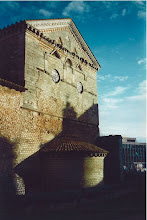Dilmun - Land of Paradise
The ancient Sumerians speak of the land of Dilmun, sometimes described as "the place where the sun rises" and "the Land of the Living.' It is the scene of a Sumerian creation myth and the place where the deified Sumerian hero of the flood, Ziusudra (Utnapishtim), was taken by the gods to live for ever. A Sumerian poet waxed: "The land of Dilmun is holy, the land of Dilmun is pure."
The civilization of Dilmun was founded during the Bronze Age and lasted in one form or another for over 2000 years. Dilmun developed as a centre of trade and commerce because of its location along the trade routes linking Mesopotamia with the Indus Valley. Its decline dates from the time the Indus Valley civilization fell in the middle of the second millenium BC. Once the decline had set in it continued over the following centuries. There is mention of Dilmun as a vassal of Assyria in the 8th century BC and by about 600 BC it had been fully incorporated into the Neo-Babylonian Empire. There is virtually no information about what happened between Dilmun's absorption by the Chaldean Empire and the arrival of Nearchus, an Admiral in Alexander the Great's forces. The Greeks referred to the place as Tylos, although the civilization they found there was probably distinct from ancient Dilmun.
Dilmun is often referred to in Sumerian and Mesopotamian mythos as the Land of Eternal Youth and Paradise and is sometimes reported as the place of the fabled Garden of Eden. It is described as paradise in the Epic of Gilgamesh.
Once rich in pearls, fresh water, and date palm oases, with a 'smoking mountain' in the midst and an intriguing solitary tree nearby, this land will become my home for my working exile, my 'forty days in the desert'; and although urbanization has come even to paradise yet it is a little land and the wilderness is not far away . . .
The civilization of Dilmun was founded during the Bronze Age and lasted in one form or another for over 2000 years. Dilmun developed as a centre of trade and commerce because of its location along the trade routes linking Mesopotamia with the Indus Valley. Its decline dates from the time the Indus Valley civilization fell in the middle of the second millenium BC. Once the decline had set in it continued over the following centuries. There is mention of Dilmun as a vassal of Assyria in the 8th century BC and by about 600 BC it had been fully incorporated into the Neo-Babylonian Empire. There is virtually no information about what happened between Dilmun's absorption by the Chaldean Empire and the arrival of Nearchus, an Admiral in Alexander the Great's forces. The Greeks referred to the place as Tylos, although the civilization they found there was probably distinct from ancient Dilmun.
Dilmun is often referred to in Sumerian and Mesopotamian mythos as the Land of Eternal Youth and Paradise and is sometimes reported as the place of the fabled Garden of Eden. It is described as paradise in the Epic of Gilgamesh.
Once rich in pearls, fresh water, and date palm oases, with a 'smoking mountain' in the midst and an intriguing solitary tree nearby, this land will become my home for my working exile, my 'forty days in the desert'; and although urbanization has come even to paradise yet it is a little land and the wilderness is not far away . . .


